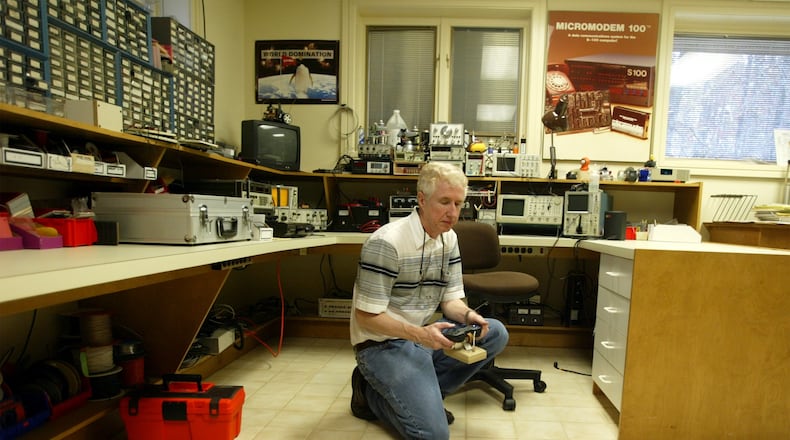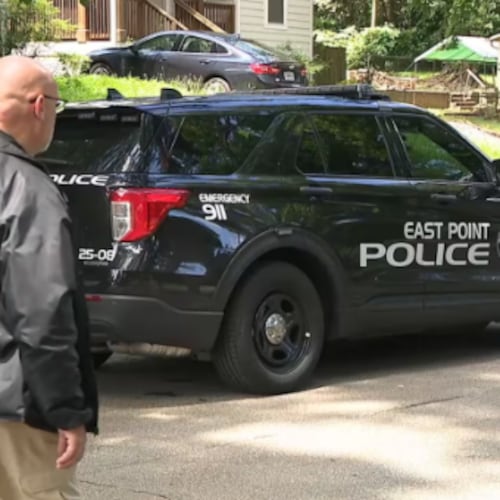Dale Heatherington played a leading role bringing the internet into American homes.
But you almost certainly have never heard of him, though he lived in metro Atlanta.
Now, nearly three years after his death, he’s about to get a bit more public recognition. Nothing huge. But something.
Heatherington co-founded Hayes Microcomputer Products, which created early modems that made it easier for millions of people to get online for the first time using home computers. At the dawn of the internet, the devices helped introduce the masses to what was ahead.
He helped launch the company, owned half of it, worked out the design of its key products, and had his name on crucial patents. But it was his business partner, Dennis Hayes, whose name was on the modems, who became the public face of the Gwinnett County-based company that at one time supplied roughly half of the country’s retail modems.
Heatherington spent his final decades mostly tinkering, often in the backyard workshop of his north Fulton home, where his attention swiveled from ham radios to making homemade tracking collars for his cats and, eventually, perfecting competitive battle robots.
For those close to him, though, Heatherington is about to get a bit more of what he’s due. On Thursday, the Computer Museum of America will make him the first inductee in its new Hall of Fame.
Many people haven’t heard of the museum either. Five years ago it moved into a permanent location in a former shopping center in Roswell. Just under 10,000 people visited last year.
“We are still meeting people who live five miles from us who say, ‘I didn’t know you were here,’” Executive Director Rena Youngblood says.
Credit: Jason Getz
Credit: Jason Getz
Bringing modems to the people
In the early days, big businesses and universities could use expensive modems to connect computers through phone lines. But hobbyists relying on kits to piece together computers had fewer good, affordable ways to do the same.
Hayes and Heatherington launched their first modem in the 1970s, before even the internet existed, and continued to roll out new dial-up versions. They gave the general public a far easier, more automated option than the clunky acoustic couplers that had been in use and were prone to disconnections.
The devices Heatherington designed worked with lots of computers and were perfectly timed with the rise of what became the internet in the 1980s. Behind-the-scenes commands that Heatherington developed became the standard for years and inspired later developments in how computers and other devices communicate with one another.
“Every time you connect to the internet you have to thank these guys who figured out how to do that,” says Arijit Raychowdhury, the chair of Georgia Tech’s School of Electrical and Computer Engineering.
Credit: AJC staff
Credit: AJC staff
Rivals licensed Hayes technology, then later moved faster and cheaper to build modems that could handle higher speed connections. Eventually many consumers got their internet service through cable TV providers that supplied modems in their own equipment packages.
Twice the company filed for bankruptcy court protection in the 1990s, before it ended operations in 1999.
The pace of technological change is often brutally fast. Obsolescence can follow close behind the leading edge.
“You catch a good wave, you can have a nice ride. But the wave and the ride don’t last forever,” says Dennis Hayes, who is now 74 and living in Spartanburg, S.C.
Heatherington jumped off the wave long before it petered out.
Hayes, who was chief executive officer and contributed technical ideas, said he was shocked when his business partner announced in 1984 that he would be leaving. Heatherington turned in his ownership stake, collecting a gradual payout that was never publicly detailed but thought to be on the order of $20 million. He was 36 years old.
“I just wanted out of the rat race,” Heatherington told a reporter years later when asked why he left the company while it was still growing.
Ann Heatherington, his widow, says her husband didn’t pursue the limelight. “He would be very humble. He never sought that.”
When Heatherington left the company, his title was simply senior design engineer.
Chevy mechanic, stereo repair man
As a kid, Heatherington was constantly pursuing ideas. He made wind-powered carts, worked with little rockets, created his own radio and TV transmissions. He described flunking out of his first college, where he focused mostly on changing out the engine in his ‘57 Chevy.
At his second college, Southern Technical Institute, now part of Kennesaw State University, he had a “C” average. He earned an associate degree while pursuing other interests, including scouring for electronic parts, creating a master key to open campus doors and devising an intercom system between dorm rooms.
He got a job repairing stereo receivers. He met Hayes later in the 1970s when they both worked at National Data Corp. in Atlanta. They’d eat lunch together and discuss evolving technology. They came up with concepts for a new modem and agreed to start a business.
Hayes says Heatherington suggested putting just the Hayes name on the company because that’s who would be out drumming up customers. Ann Heatherington says her husband told her using his own name would be too long.
Heatherington was always most comfortable at the workbench, rather than managing people or pursuing sales.
He was quiet at industry gatherings and people probably mistakenly thought he was just another engineer with the company, says Richard Bodor, who in the 1980s worked for a local computer manufacturer and only years later got to know Heatherington personally.
Hayes and Heatherington could disagree on technical innovations, but they appeared to respect one another. They did not stay in close contact after Heatherington left the company, “but they were cordial with one another,” says Heatherington’s widow.
The Heatheringtons went on a blind date in the early 1980s, when she was a senior research scientist at the Georgia Tech Research Institute. She had a doctorate in computer science. By the third date, she knew he was the one.
“It was absolutely his brain I fell in love with,” she says.
They were married for 32 years.
When Heatherington retired from the company he indulged in what he loved as a kid: pursuing whatever engineering adventure called to him.
He enjoyed the luxury of time, but he preferred fast food and pizza to fine dining. He didn’t care for extravagance or crave travel. “He was generally a homebody,” Ann Heatherington says.
He put a giant radio tower in their yard, set up a radar detector for speeders on the street out front, and stationed monitors to track everything from the climate inside their home to whether postal workers had slipped letters into the mailbox.
Credit: SPECIAL
Credit: SPECIAL
But Heatherington eventually discovered some of his greatest joys were designing competitive battle robots and contemplating every detail, such as experimenting with putty and sticky foam insulation to improve the grip of his bots’ tires.
He joined the Atlanta Hobby Robot Club and frequently won local battle robot competitions, including at the annual Dragon Con convention in Atlanta. He donated homemade robots for a fellow club member to take on demonstrations for school kids around the state. He also made donations for a mechatronics lab at Kennesaw State University that it named after him.
Ann Heatherington says her husband died in 2021 of “an electrical failure in his heart, which I found ironic because he was an electrical engineer.”
Had he known of the problem, she says, “you know he would have been trying to fix himself.”
A nod on ‘Jeopardy’
While Heatherington was still with the company, a local business magazine described Hayes as “the wonder boy of Atlanta business in the 1980s.” Hayes was inducted into the Georgia Technology Hall of Fame, and he traveled to Las Vegas when he was named to the IT industry’s Hall of Fame in 2003, along with computer titan Michael Dell and others.
About five years ago, Heatherington was invited to join Hayes at a Peachtree Corners gathering celebrating the Atlanta technology pioneers. And once he caught sight of this question on TV’s Jeopardy game show: “In 1977 Dennis Hayes & Dale Heatherington invented this, enabling a PC to transmit data via phone lines.”
Over the years, though, modems became just another behind-the-scenes piece of equipment. And memories of even Hayes faded some.
Hayes later opened a local bar briefly, joined other companies, worked as a part-time executive and recently helped start an organization to mentor entrepreneurs. He says he now has a seeing eye dog and can no longer see what’s on the Internet, relying on his phone or Alexa to read text aloud.
Financially, “I’m not wealthy, but I’m OK,” Hayes says.
As for Heatherington, Hayes says it would be great for people to know what he did.
“He took a soldering iron and turned piles of chips and wires into gold.”
Hall of Fame for both, eventually
The new hall of fame at the Computer Museum of America in Roswell won’t take up much space.
A plaque will be put up in Heatherington’s honor. It will hang near a Hayes modem that is part of the museum’s regular display. The small device, initially designed to fit under the base of a landline phone, is nestled between cases filled with other items once considered to be the new hot things, only to be eclipsed.
Credit: Jason Getz
Credit: Jason Getz
There’s a TRS-80 portable computer, a 3.5″ diskette of the CubeMaster computer game, a Nintendo GAME Boy, a Sony Walkman with headphones, a GE Carfone 5000 with its zip up case. Nearby are other early computers, nostalgic arcade games, an electric typewriter, bulky servers and technology tied to space exploration.
About 200 guests are expected at the museum’s annual fundraiser on Thursday, when Heatherington will be named the first winner of its Visionary Award.
Ann Heatherington says she’s thrilled, even if it’s not something her husband would have pursued.
Charles Guan was a young teenager when he met Heatherington at robot club gatherings.
“I only knew him as Dale, one of the club guys,” says Guan, now a Georgia Tech Research Institute research engineer.
Heatherington was a mentor and taught him humility, he says. And they shared a bit of the same perspective: taking satisfaction from being part of creating something important, regardless of who gets remembered for it.
“Society forgets 99.999% of everyone who ever lived,” Guan says. “You always hear about King Tut. You never hear about the guy who built the tomb, who was the chief engineer of the pyramid.”
Credit: Matt Kempner
Credit: Matt Kempner
About the Author
Keep Reading
The Latest
Featured







